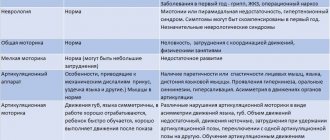Definition
Phonemic awareness is the ability to distinguish, analyze and differentiate heard phonemes - this is phonemic awareness. The baby's sound analyzer is turned on immediately after birth.
He listens to voices and reacts to them. After 6-7 months, he imitates the conversations of adults, copying syllables and individual sounds. By 12 months - says the first word.
In this way, acoustic images of individual phonemes are formed. Children can mix and replace them, this is considered the norm until a certain age. By the age of 4, the child should have a good grasp of the technique of pronunciation of most sounds of his native language. The only exception is -. If this does not happen, then we can talk about dyslalia - phonemic hearing impairment. It is important that incorrect pronunciation does not become a habit; the child must learn to control the clarity of speech, listen carefully to others and to himself.
WHY DOES IT NEED TO BE DEVELOPED?
Without understanding the sound features of the speech of others, it will be difficult for a child to learn to speak. With developed phonemic hearing, the baby realizes that he is pronouncing the word incorrectly and tries to independently achieve the correct pronunciation. If the difference between similar sounds is not caught, stable substitutions “beetle - kuk”, “shishka - detective” are formed. The worse the phonemic hearing is developed, the more pronounced the speech problems. In such cases, they say that children feel like they have porridge in their mouth.
If a problem is not solved in preschool age, many new, much more serious ones arise from it. The child has difficulty reading, writing, and learning other languages. He has difficulty merging syllables, isolating individual sounds, he writes endings incorrectly, and much more. Schoolchildren begin to fall seriously behind in their school curriculum.
How it manifests itself
Mixing sounds and substitutions provoke dyslalia. Its presence can be determined by the following signs:
- Violation of sound pronunciation. Substitution of sound, for example, voiced sounds are perceived and pronounced as voiceless, hard sounds as soft.
- Omitting consonants and vowel phonemes in words, rearranging them, adding extra sounds. For example, sLobodny, instead of svobodny, dereLa instead of tree, etc.
- Weak differentiation of similar phonemes, their replacement in oral and written speech. For example, mixing and replacing s, z, w - rat instead of roof, bough instead of beetle.
Impaired phonemic hearing in children leads to errors in grammar. The most common spelling errors are unstressed vowels, double consonants, and unvoiced words at the end of a word. The student simply does not hear the impact sound. For him it is similar to an unstressed word, so it is difficult for him to select a test word. At school, such children fail not because of mental retardation or poorly developed intelligence, but because of impaired phonemic hearing.
Phonemic hearing impairment. How to overcome it?
The ability to focus on sound is a very important human characteristic. Without it, it is impossible to learn to listen and understand speech - the main means of communication. It is also important to distinguish, analyze and differentiate phonemes by ear. This skill is called phonemic awareness.
For the development of a child’s speech, his full hearing is very important. The auditory analyzer begins to function from the first hours of a child’s life. The child's first reaction to sound is dilation of the pupils, holding his breath, and some movements. Then the child begins to listen to the adult’s voice and respond to it. In the further development of a child's speech, hearing begins to play an important role. At the age of 7-9 months, the baby begins to imitate the sounds of speech of others. By the age of one year he begins to speak his first words.
Thus, the child masters the ability to subordinate the activity of his articulatory apparatus to signals coming from the auditory analyzer. With the help of hearing, the baby perceives the speech of others, imitates it and controls his pronunciation.
In early childhood, a child perceives sounds, syllables and words unclearly and distortedly. Therefore, children mix one phoneme with another and poorly understand the speech of others. Very often, children do not notice their incorrect pronunciation, so it becomes habitual, persistent and subsequently overcome with great difficulty.
The development of phonemic awareness occurs gradually, in parallel with the formation of pronunciation. Usually, by the age of 4, a child masters the ability to distinguish all the phonemes of his native language by ear, provided that the child is in a favorable speech environment - adults talk to him, read fairy tales to him, teach him poetry. And gradually the child masters the correct pronunciation. By the age of 4, a child should already be able to pronounce all sounds correctly, except [l], [r]. And by the age of 5, the correct pronunciation of all sounds of the native language and mixing of phonemes is not allowed ([s]-[w], [zh]-[z], [k]-[t], [p]-[l], etc. P.).
The role of phonemic hearing for the development of all speech functions necessary for mastering reading and writing is indisputable. It is no coincidence that children with unformed phonetic-phonemic perception have difficulties in mastering literacy.
When they come to school, they often find themselves among the underachievers. The specificity of their phonemic perception leads to fragile, superficial, fragmented knowledge and skills not connected into a single system. This “passive” baggage cannot provide the basis on which further learning can be successfully built.
The lack of full perception of phonemes of the native language makes it impossible for children to pronounce them correctly. In addition, impaired phonemic hearing does not allow children to master vocabulary and grammatical structure to the required extent, and, therefore, inhibits the development of coherent speech in general. This means that eliminating severe speech defects is impossible without special correction of phonemic processes.
Signs of phonemic hearing impairment are:
- Violation of sound pronunciation (replacement and mixing of sounds).
- Violations of the sound structure of a word, which manifests itself in errors in sound analysis (omission of vowels and consonants of letters, syllables; insertion of letters; rearrangement of letters, syllables).
- Impaired differentiation of sounds by ear that have acoustic-articulatory similarities, manifested in the replacement and mixing of sounds, and when writing, in the mixing of letters.
As practice has shown, students with hearing loss make many mistakes on grammatical rules, for example, on unstressed vowels, double consonants, and soft separating signs. The child does not hear the stressed vowel, therefore it is difficult to identify the unstressed vowel, and, consequently, to correctly select the test word.
Overcoming phonemic hearing disorders is one of the main directions of speech therapy work in the process of correcting various speech disorders.
Speech therapy work is carried out in the following sequence:
- Isolating a sound against the background of a word, i.e. determining the presence of a sound in a word.
- Determination of the first and last sound in a word, as well as its place (beginning, middle, end of the word).
- Development of complex forms of phonemic analysis (determining the sequence, quantity and place of sounds in relation to other sounds in a word).
Mastering the skills of sound-syllable analysis is of paramount importance for the correction and formation of the phonetic side of speech and its grammatical structure, as well as for the ability to pronounce words with a complex syllabic structure.
Based on sound analysis and synthesis, children master reading syllables and words. Awareness of the sound structure of a word and work on sound analysis and synthesis are a necessary prerequisite for learning to read and write.
By conducting classes with children in a playful way, we thereby arouse interest in educational activities and achieve positive dynamics in the correction of phonemic underdevelopment, helping children prepare for further education at school.
Exercises to develop auditory attention
"Guess what's making the noise."
Show your child what sounds various objects make (how paper rustles, how a tambourine rings, what sound a drum makes, what a rattle sounds like). Then you need to reproduce the sounds so that the child does not see the object itself. And the child must try to guess what object makes such a sound.
"Conversation in a whisper."
The task is for the child, being at a distance of 2 - 3 meters from you, to hear and understand what you say in a whisper (for example, you can ask the baby to bring a toy). It is important to ensure that the words are pronounced clearly.
“We hear a ringing and don’t know where it is.”
Ask your child to close his eyes and ring the bell. The child should turn to face the place from which the sound is heard and, without opening his eyes, show the direction with his hand.
Exercises to develop phonemic awareness
- clap your hands and count to five (eight, ten);
- draw as many circles as I clap;
- close your eyes, listen and repeat: ay, uua, io, iau, ia;
- name the first sound: ay, ia, oi; last sound: ai, auo, ai; second sound: ia, aua, ooi;
- game "Catch the Sound". The adult names a series of sounds, and the child must clap his hands when he hears the sound, for example, [l]: [m], [n], [l], [v], [r], [l], [l], [d], [l]…. It must be pronounced clearly;
Then in syllables: ma, ka, la, va, lo, to, ro, do, you, ry, we, ly,..;
Similarly in the words: loto, hole, bath, care, paw, rainbow,.;
- choose pictures that: begin with a sound: [a] ([y], [m], [v], etc.); begin with a syllable: ta (ly, vo, su, etc.)
- determine the last sound in the words and type the desired letter: eyes, face, lips, grew, moss;
- identify the same sound in the words: butterfly, drum, bun, loaf;
- Game "Fix Me" The adult says the word correctly and incorrectly, and the child claps his hands when the word is said correctly.
Car, apple, candy
mafyna, yaboko, coffee
Masyna, Yabyaka, candy
car, apple, cassette tape;
- think of words with a given sound, for example, [t] at the beginning of a word, in the middle and at the end of a word;
- remember words with the sound [v] ([a], [m], etc.) that will appear in the fairy tale;
- game "Add sound". What word will you get if you add a sound, for example, [k] at the end of the word: ox - wolf, fish - fisherman, tomorrow - breakfast, steam - park;
- game "Take away the sound." What word will you get if you remove the first sound: braids - wasps, mole - mouth, laughter - fur;
- game "Insert the missing sound." Insert a sound, for example, [l] so that it becomes the second in the word: kok - klok; sweat - raft; side - block; dream, cube, owl, cup, dry, gas.
Prepared by teacher-speech therapist Ivanovskaya T.P.
Causes
The central and peripheral nervous systems are responsible for speech hearing. The negative impact on them is the impetus for acoustic dysfunctions. The main causes of the disease can be:
- Weakening of the body at any age, especially early
- Infectious diseases
- Digestive problems
Lack of vitamins and minerals leads to lethargy, isolation, and apathy. Attention, level of concentration, memory weakens.
- Thyroid diseases
Hypothyroidism is especially dangerous at an early age, in newborns. Lack of hormones or their abundance have a strong impact on brain processes and mental development.
- Hyperactivity
It is difficult for the child to concentrate; he does not listen to the conversations of adults or their speech. Captures phonemes fragmentarily and also reproduces them.
- Hearing loss
- Injuries to the head, speech and hearing organs
- Unfavorable social environment
- Negative example
The parents have obvious, advanced speech defects that were not corrected in childhood.
Regardless of the causes of phonemic hearing impairment, you should contact a speech therapist, laryngologist, or neurologist as early as possible. Only a special examination and identification of the causes of the disease will help make a diagnosis and correct defects in a timely manner.
WHAT IS PHONEMIC HEARING?
The auditory analyzer, the organ of hearing, which includes the ear, nerves and special centers in the cerebral cortex, is responsible for the ability to hear. It converts sound vibrations into nerve impulses, which are then transmitted to the central parts of the brain and cause certain human reactions. There are two types of hearing: physical and phonemic. The first determines the ability to perceive natural and household noise, as well as music.
Phonemic hearing allows you to hear and distinguish the sounds of human speech. Thanks to him, the child learns not only to understand speech and speak, but also to grasp the meaning of what is said, depending on the nature of the sounds (intonation, stress, endings, etc.). For example, hearing the difference between the similar “bear” and “bowl”, the mournful “oh” and the surprised one, the flowers “carnations” and daddy’s “carnations”.
Diagnostics
It is important to conduct phonemic hearing assessments in preschoolers before entering first grade. They are done by a speech therapist, a speech therapist and parents. Diagnostic techniques were developed by G.A. Kashe, T.B. Filicheva, G.V. Chirkina . Surveys are successfully used in schools, kindergartens, and at the PMC commission.
A specialist working with children uses the following methods to diagnose acoustics and speech defects:
- Determining the sound source (non-speech)
The subject is asked to listen to a musical instrument with his eyes closed, and then say what sound it made. Tambourines, rattles, drums, and bells are used.
- Distinguishing phonemically similar words
Exercise “Attentive ears”.
In front of the subject are pictures depicting objects familiar to him. These are fruits, animals, toys, etc. An adult pronounces a group of words that are phonetically similar to each other, one of them names a drawn object. The subject must pick up the picture when he hears the correct name of the picture.
For example, in the picture there is a pear. An adult slowly pronounces: gruf, glyusya, pear, glusa, etc.
Any raising of a picture without an exact name is considered an error.
Another option for conducting diagnostics using words that sound the same is “Show it yourself.” The preschooler receives pictures depicting objects. For example, hummock - bud - daughter; goat-scythe-vine; puddles-skis, etc. at the request of the teacher, points to the object that was named to him.
- Syllable differentiation
The ability to distinguish between soft and hard and voiceless and voiced consonants is tested by repeating what is heard.
The teacher says: Cha-cha-cha, mu-mya-ma. The child must repeat a group of syllables.
- Phoneme differentiation
“Clap your hands”
The preschooler listens to a set of sounds, clapping his hands if he notices the phoneme indicated by the speech therapist.
For example, find M in the sound row.
- Sound analysis
Surveys are based on identifying individual phonemes in a word. For example, a stressed vowel, the first sound or the last, the number of phonemes before and after the desired sound.
For analysis, words with 3 sounds are offered, if the child is over 5 years old - from 4-5.
- Phoneme representation and word selection
A more complex study based on phonemic analysis of representations. The subject must name words with the required letter, for example, D. Or select an image in the picture whose name has 4-5 letters.
Based on the results of diagnosing phonemic hearing impairment, the teacher:
- draws up an individual defect correction program;
- refers for further medical examination if necessary to identify the causes of the disease.
Using these analysis methods, it is possible to trace the dynamics of the development of acoustic abilities and the effectiveness of corrective measures.
HOW TO CHECK PHONEMIC HEARING?
The easiest way is to consult a specialist. A speech therapist deals with issues of phonemic hearing impairment. The initial consultation is carried out at 3 years. At this age, it becomes clear whether the baby needs any help or whether development occurs according to age. At 5 years old, a child should already be able to clearly understand sounds and speak correctly (with the exception of the sound “r”). If this is not the case, special correction classes are needed.
Parents themselves can check their child’s phonemic hearing using a small test:
- Invite the child to choose a picture with a picture of a bear (they give two options, with a picture of a bear, and bowls - plates).
- Ask to stamp your foot when you hear the syllable sa. The adult says at the same pace: wa-ta-za-za-sa-ka-za.
- Ask your child what is the difference between cancer and varnish?
- Ask to come up with words for the vowel sounds “A”, “O”, “E”, “I”, “U”.
Correction
Phonemic hearing impairment in children is treated comprehensively. What to drink or how to exercise, you need to find out from specialists: a neurologist, psychiatrist, speech therapist, speech pathologist. Medical care is provided along with active classes with teachers.
Drug treatment
You cannot teach speech with the help of medications, but their use helps improve the functional state of the brain and blood flow. An increase in brain performance is directly related to an increase in memory capacity and the ability to concentrate. Kids have to work hard, try to remember new things, and monitor their own and other people’s speech. Pills and injections help him in this difficult process.
Most often, a neurologist and speech therapist prescribe:
- Pantogam
Stimulates the central nervous system, reduces excitability, increases mental performance.
- Glycine
Relieves emotional stress, aggression, improves sleep.
- Phenibut
Normalizes metabolism in tissues and blood circulation in the brain. Relieves feelings of fear, anxiety, increases performance.
- Cortexin
Restores brain function after injury and stress. Improves memory, attention, increases the level of learning.
Simultaneously with taking medications, massage and exercise therapy are prescribed. Parents should also monitor the baby’s nutrition. Add more meat dishes and fruits to your diet. Pay attention to the hemoglobin level.
General recommendations for classes
Almost all experts adhere to the following advice:
- All classes should be held in a playful way. Let it be a pleasure, not a workout.
- While practicing, we follow the sequence of stages. There is no need to count on instant results: everything will come gradually.
- The younger the child, the shorter the lesson time. At 2-3 years old, 10-15 minutes will be enough.
- If the baby is in a bad mood or tired, it is better to postpone the exercises.
- If interest is lost, we immediately switch our attention to another activity.
- To get rid of uniformity, we use various toys, pictures and poems.
- Take breaks for physical exercise or a joint search for something interesting to do.
- We praise the child even for minimal successes: even if he didn’t succeed, he tried. The child should feel confident in his own abilities. We avoid criticism and negative marks. This can completely ruin your motivation.
- We return to the material we have covered in everyday life. For example, you can practice putting accents while you are shopping, and read the necessary words for this on the shelves with goods. When preparing lunch, ask your child to find all the foods in the kitchen that start with a certain letter.
REFERENCE! Play is the leading activity in preschool age. In its process, the baby gets acquainted with the world around him. This is how norms of behavior and relationships are formed.
The number of preschool children with speech development disorders has been growing recently. But regular classes will definitely bear fruit in the form of correct speech and competent writing. Don't be shy about asking speech therapists for help.
![Hard and soft sound [d]](https://ls-kstovo.ru/wp-content/uploads/tverdyj-i-myagkij-zvuk-d3-330x140.jpg)









